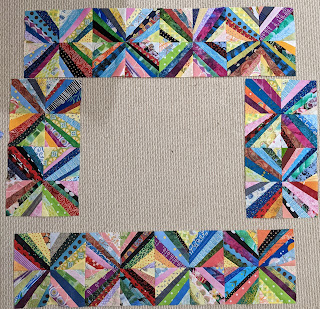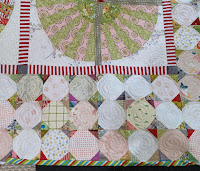A party without cake is really just a meeting.
~Julia Child
Quilting
So many household repairs needed attention that it was hard to push forward on the tulips. How did you all do? It's no problem if you're behind; we're all working at our own pace. And several quilters have branched in their own directions. For example, Kaja pieced tulips and Julie created an applique so lively I can see the blooms blowing in a breeze. Not only are her colors gorgeously bold, but her tulips are strung horizontally across the petals rather than vertically. Be sure to take a look.
Although I'm sharing directions, this is improvisation. Do what you want whether they are tulips, strings or something completely different. My directions are there simply to help people who are more hesitant and the many people who asked how I made the ESS blocks.
This month we'll appliqué the center and put the top together. As usual, these are just suggestions, hopefully enough to get beginners started. There are many ways to accomplish these steps; this is just the one I used. Look at YouTube for other methods.
 |
| String Tulips quilt |
Sew the Borders
We left off with the center cut two-inches larger than the finished dimensions of the ESS blocks. Remove the paper from the ESS blocks and lay them out as a border. Sew the four sides together so the lengths can be verified. Press the borders carefully {NO ironing and NO steam} because all the sides are bias.
 |
| For ESS string block borders sewn |
Find the Center
Once the length is established, fold the center {that was cut an inch or two wider} into quarters and press.
 |
| Center of String Tulips is quartered and pressed |
Marking a perimeter keeps the tulips from creeping into the seam allowance. The center may shrink up a bit once the appliqué is done which is why a washable marker was chosen and why we added an inch or two extra to the center. If your string blocks are a different length than mine, change the measurements.
Center the ten-inch marks of the ruler on the center crease then draw the perimeter with the marker. {Or half your personal border width.} Repeat for each quarter of the center.
 |
| Marking the center perimeter with ruler and washable marker |
Prepare Tulips
Previously I needle turned the tulips but this time I hand basted the seam allowance. Or use raw edge appliqué or any other method.
 |
| Basted seam allowance of tulip |
When they are all ready, pin them to the center background. Eyeball the location or measure with a ruler as long as they are inside the marked line. Try to position the center petal along the main diagonals with the point toward the corner.
 |
| String Tulips pin basted to the center |
Prepare Stems
Measure the diagonal distance between two tulips to calculate how long the stems will be. Add an inch or two to slide under the flower bases. It can be trimmed back later but it would be a shame to run short.
For sturdy stems use binding remnants. Stems can easily be changed to any width you like. Mine were cut 2.25-inches and finish about 1.125".
Stems don't have to be green. Try unexpected colors to see what happens.
 |
| Four possible stem choices for String Tulips |
Open the binding and press both edges to the center.
 |
| Pressing the tulip stems |
Position the Stems
Fold the stems in half to locate the centers. Place the centers of both stems on the center of the background and extend each stem diagonally so they make ninety degree angles. Pin or glue the bottom one down. Pin or glue part of the top one down but leave one side loose to fold it back while sewing the bottom one.
 |
| Pinning the stems in place |
Once you know there is sufficient seam allowance for the stems, tuck the ends under the tulips.
Check that everything is well placed. If you are adding leaves, etc, lay those templates temporarily in place to ensure there's enough room. Adjust as needed {which could mean scooting something over or increasing its seam allowance. Note: A narrower tulip like Julie's {link at the top} leaves more room for additional appliqué pieces. Think about it.
Appliqué
Use your machine's edge stitching foot or blanket stitch to appliqué the bottom stem, starting and ending under the tulips.
 |
| Applique the stem under the tulip |
Then repeat with the top stem.
 |
| Applique the tulip stems |
Finally stitch around each tulip. Choose thread to match your fabric or not. I found it easier to start at the top right point. Slow down at the base where there's a wad of seams. Repositioning the presser foot by lifting it momentarily will help ease the sewing.
 |
| Applique the tulips |
Add Additional Appliqué
I added eight circles but you could add anything you want... or nothing at all. Since I own a set of Karen Buckley's Perfect Circles, that's what I used to choose circle sizes. Look around your house for any circles... bobbins, spice bottles, etc. Place your templates on the background to check the size.
 |
| Possible circle templates |
These fabrics from my stash repeat colors on the white print. I cut a few of each to test which would work best.
 |
| Possible circle fabrics |
Cut them out, then pin or glue them in place. Check the position then appliqué them in the same way as the tulips and stems.
 |
| Adding a circle above the tulip |
Sew the Borders to the Center
Once all the appliqué is finished, it's time to re-measure the center. This time, mark the cutting line. In my case, that's a perimeter 10.25-inches from the center for each quadrant. I lined the ruler up with the 10.25 line on those pressed lines on the background.
 |
| Mark the new sewing line for the center section |
The appliqué pulled my center in about an eighth-inch. As a check, the cutting line you are marking now will be a quarter-inch or more than the previously drawn line.
Then cut the center along that line, pin the borders to opposite sides and ease them onto the center.
Add Outer Border
The ESS blocks are all bias so I added a narrow outer border to stabilize the quilt. {The other choice is to stay stitch an eighth-inch from the edge.} Cut strips 1.75-inches by WOF and seam together as needed. My first two sides are 40.5", the length of eight ESS blocks plus two seam allowances. The second two sides are 43". Measure your blocks to determine your personal lengths.
 |
| String Tulip 3 quilt top |
Pin or mark the length and the center then pin each to a side and sew.
Ta da! Top done!
On a personal note, I'm fully Pfizered. Hopefully everyone will be vaccinated soon, the only way we can kill off this virus.
































